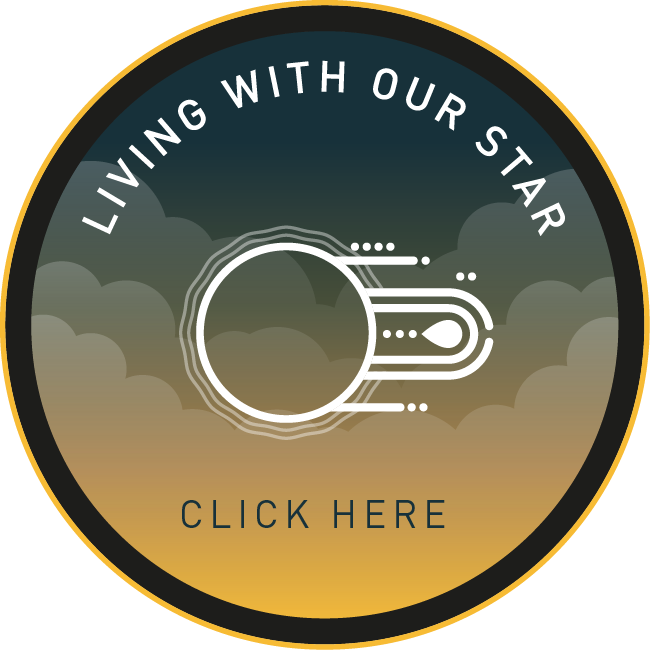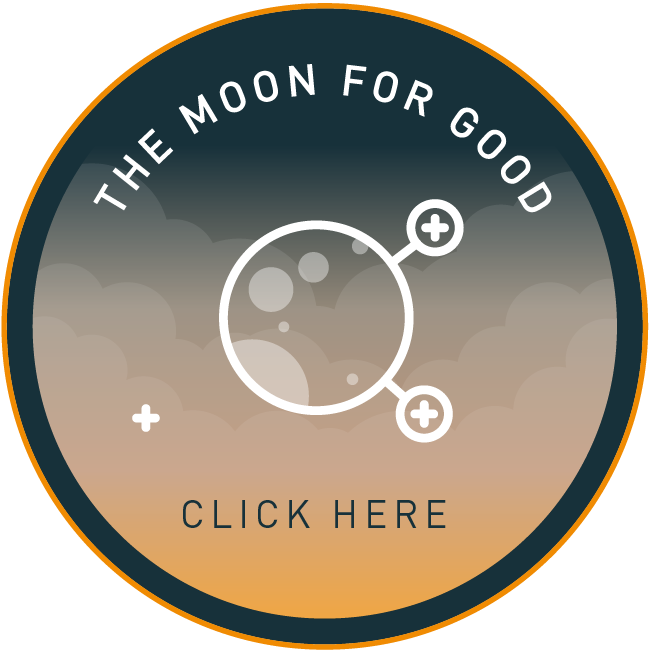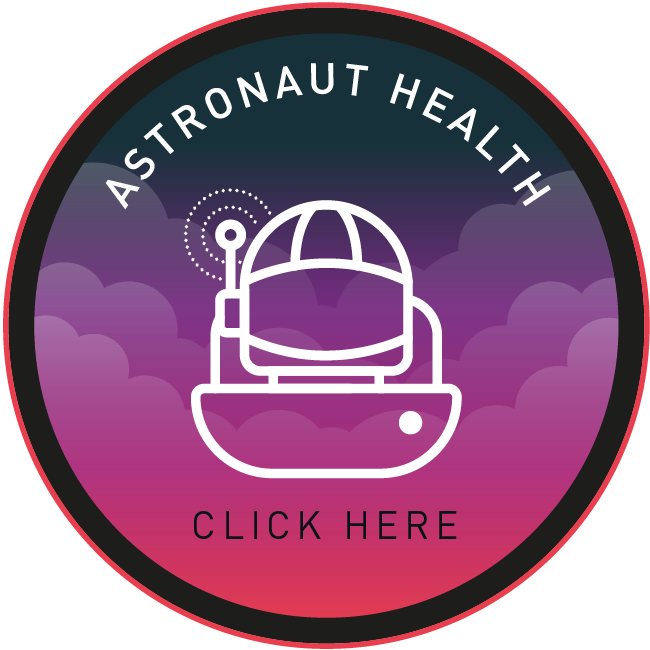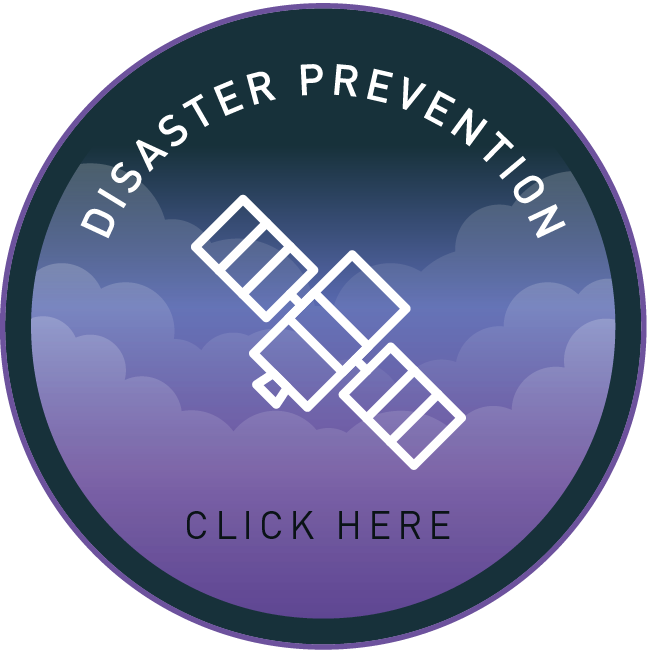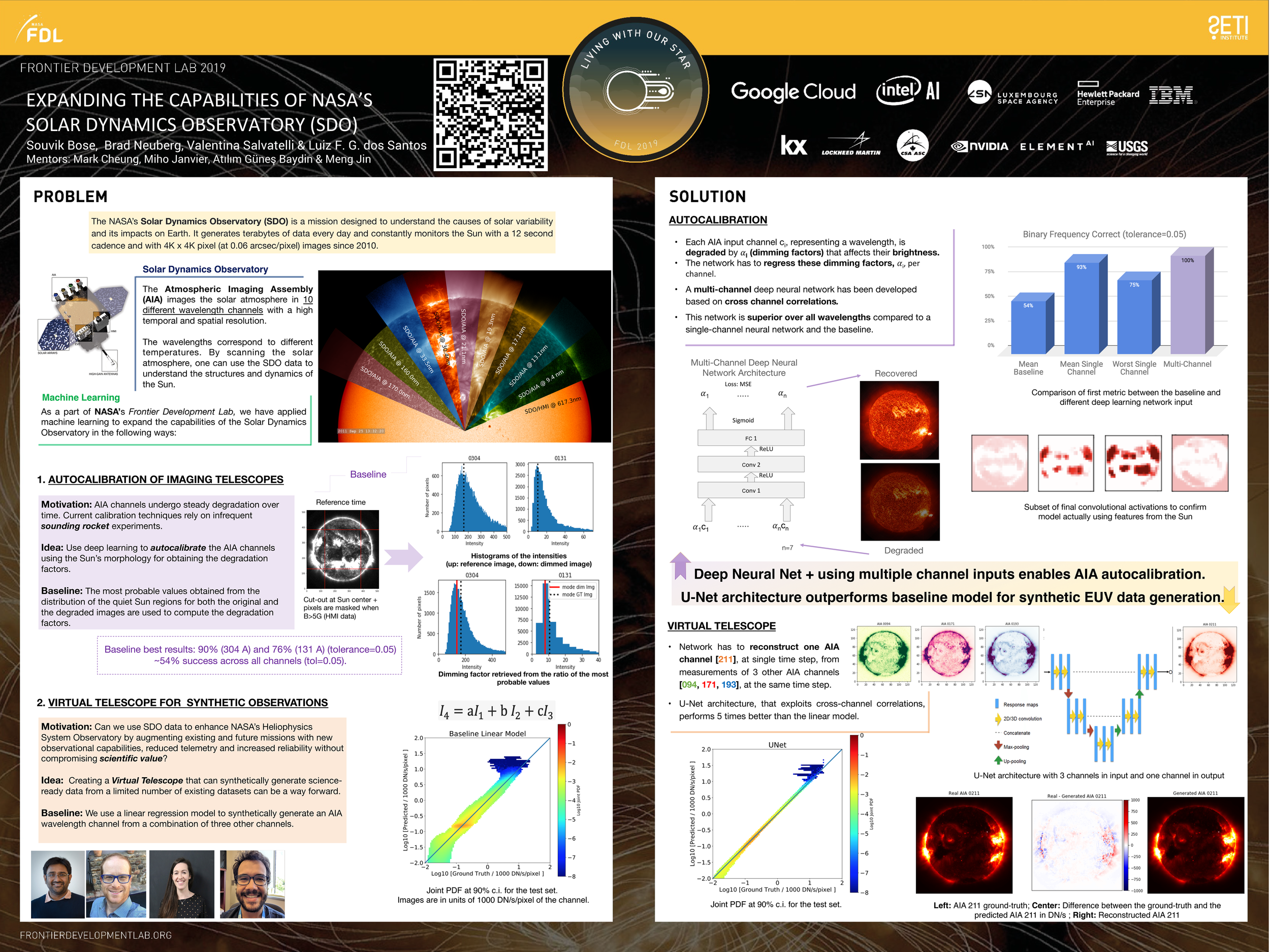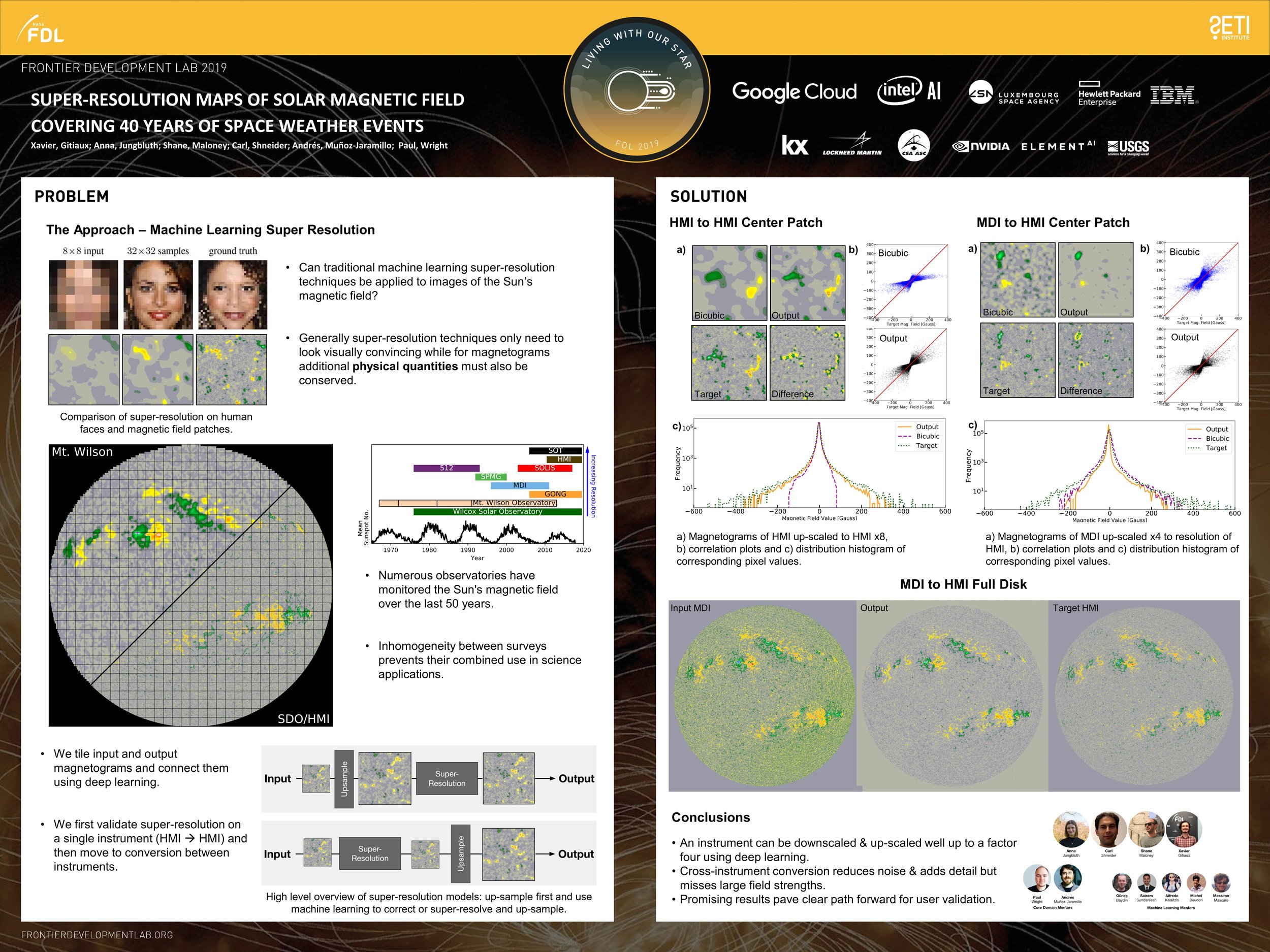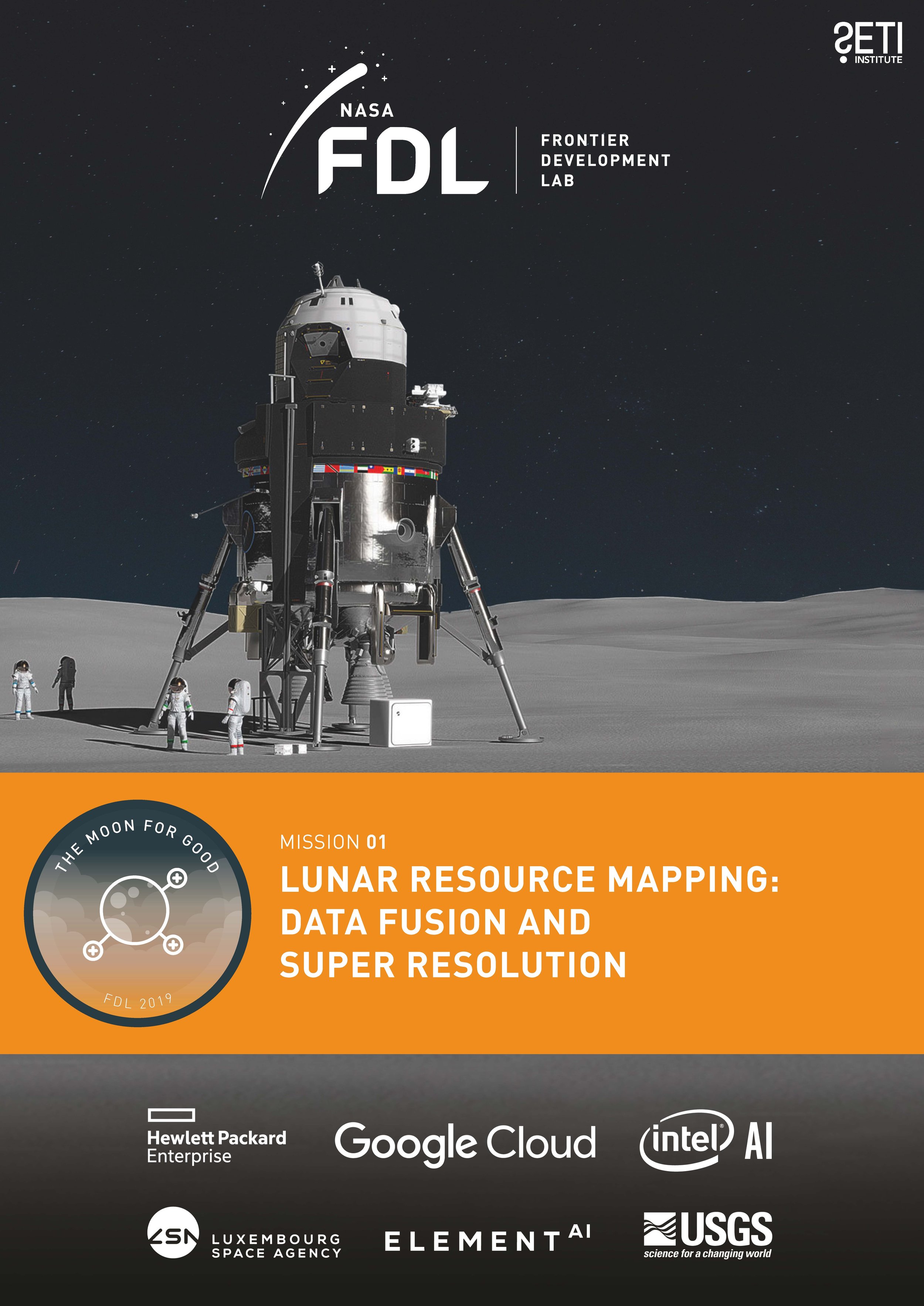
FDL 2019
In 2019 FDL tackled challenges in Heliophysics, Astronaut Health, Disaster Prevention and Lunar Exploration.
Navigate to research area
LIVING WITH OUR STAR: EXPANDING THE CAPABILITIES OF NASA’S SOLAR DYNAMICS OBSERVATORY
The team devised a way for solar extreme UV telescopes to self-calibrate, improving our capability to monitor space weather. Furthermore, the team created a synthetic telescope to image the Sun’s corona.
-
-
Living with our star: Expanding the capabilities of NASA’s solar dynamics observatory
Authors: Souvik Bose, Brad Neuberg, Valentina Salvatelli , Luiz F. G. dos Santos
Mentors: Mark Cheung, Miho Janvier, Atılım Güneş Baydin, Meng Jin -
Using U-Nets to Create High-Fidelity Virtual Observations of the Solar Corona - DOI
Authors: Valentina Salvatelli, Souvik Bose, Brad Neuberg, Luiz F. G. dos Santos, Mark Cheung, Miho Janvier, Atilim Gunes Baydin, Yarin Gal, Meng Jin
Auto-Calibration of Remote Sensing Solar Telescopes with Deep Learning - DOI
Authors: Brad Neuberg, Souvik Bose, Valentina Salvatelli, Luiz F.G. dos Santos, Mark Cheung, Miho Janvier, Atilim Gunes Baydin, Yarin Gal, Meng Jin
Astronomy & Astrophysics Journal - Multi-Channel Auto-Calibration for the Atmospheric Imaging Assembly using Machine Learning - DOI - ArXiv
Authors: Luiz F. G. dos Santos, Souvik Bose, Valentina Salvatelli, Brad Neuberg, Mark C. M. Cheung, Miho Janvier, Meng Jin, Yarin Gal, Paul Boerner, Atılım Güneş BaydinAstrophysical Journal Letters - A Machine-learning Data Set Prepared from the NASA Solar Dynamics Observatory Mission - DOI
-
AGU 2019: Auto-calibration and reconstruction of SDO’s Atmospheric Imaging Assembly channels with Deep Learning
Authors: Chun Ming Mark Cheung, Luiz Fernando Guedes dos Santos, Souvik Bose, Brad Neuberg, Valentina Salvatelli, Atılım Güneş Baydin, Miho Janvier.
AGU 2020: Multi-Channel Auto-Calibration for the Atmospheric Imaging Assembly instrument with Deep Learning
Authors: Souvik Bose, Luiz Fernando Guedes dos Santos, Valentina Salvatelli, Brad Neuberg, Chun Ming Mark Cheung, Miho Janvier, Meng Jin, Yarin Gal, Atılım Güneş Baydin.NeurIPS 2019 ML4PS - Auto-Calibration of Remote Sensing Solar Telescopes with Deep Learning
Authors: Brad Neuberg, Souvik Bose, Valentina Salvatelli, Luiz F.G. dos Santos, Mark Cheung, Miho Janvier, Atilim Gunes Baydin, Yarin Gal, Meng Jin.
NeurIPS 2019 ML4PS -Using U-Nets to Create High-Fidelity Virtual Observations of the Solar Corona
Authors: Valentina Salvatelli, Souvik Bose, Brad Neuberg, Luiz F. G. dos Santos, Mark Cheung, Miho Janvier, Atilim Gunes Baydin, Yarin Gal, Meng Jin
JPL AI and Data Science Workshop - Auto-Calibration and High-Fidelity Virtual Observations of Remote Sensing Solar Telescopes with Deep Learning - Abstract
Authors: Brad Neuberg, Souvik Bose, Valentina Salvatelli, Luiz F.G. dos Santos, Mark Cheung, Miho Janvier, Atilim Gunes Baydin, Yarin Gal, Meng Jin.
-
SpaceML.org - SDOML
A Machine Learning Dataset Prepared From the NASA Solar Dynamics Observatory Mission
SpaceML.org - SDO: Autocalibration
Multichannel auto-calibration for the Atmospheric Imaging Assembly using machine learning
-
-
Living with our star: super-resolution maps of solar magnetic field covering 40 years of space weather events
Authors: Xavier Gitiaux, Anna Jungbluth, Shane Maloney, Carl Shneider, Atılım Güneş Baydin, Alfredo Kalaitzis, Michel Deudon, Yarin Gal, Andrés Muñoz-Jaramillo, Paul Wright -
Single-Frame Super-Resolution of Solar Magnetograms: Investigating Physics-Based Metrics & Losses - DOI
Authors: Anna Jungbluth, Xavier Gitiaux, Shane A.Maloney, Carl Shneider, Paul J. Wright, Alfredo Kalaitzis, Michel Deudon, Atılım Güneş Baydin, Yarin Gal, Andrés Muñoz-Jaramillo -
AGU 2019: A Deep Learning Approach to Forecast Tomorrow's Solar Wind Parameters
Authors: Carl Shneider, Enrico Camporeale, Mandar ChandorkarNeurIPS 2019 - Single-Frame Super-Resolution of Solar Magnetograms: Investigating Physics-Based Metrics \& Losses
Authors:Anna Jungbluth, Xavier Gitiaux, Shane A.Maloney, Carl Shneider, Paul J. Wright, Alfredo Kalaitzis, Michel Deudon, Atılım Güneş Baydin, Yarin Gal, Andrés Muñoz-Jaramillo
COSPAR 21 - Autonomous deep-space missions: can deep learning be used to optimize data transmission - Video
Authors:Valentina Salvatelli, Souvik Bose, Brad Neuberg, et al.
COSPAR 21 - Automating the Calibration of the Atmospheric Imaging Assembly - Video
Authors: Luiz Fernando Guedes dos Santos, Souvik Bose, Valentina Salvatelli, et al.
-
Gitlab - Super Resolution
Spaceml.org - Super Resolution Maps of the Solar Magnetic Field
State of the art deep neural networks to calibrate and super-resolve historical maps of the solar magnetic field.
-
-
Living With Our Star: Enhanced Predictability of GNSS Disturbances
Authors: Kara Lamb, Garima Malhotra, Athanasios Vlontzos, Edward Wagstaff, Asti Bhatt, Atilim Günes Baydin, Anahita Bhiwandiwalla , Yarin Gal, Alfredo Kalaitzis, Tony Reina -
Correlation of Auroral Dynamics and GNSS Scintillation with an Autoencoder - DOI
Authors: Kara Lamb, Garima Malhotra, Athanasios Vlontzos, Edward Wagstaff, Atılım Günes Baydin, Anahita Bhiwandiwalla, Yarin Gal, Alfredo Kalaitzis, Anthony Reina, Asti BhattPrediction of GNSS Phase Scintillations: A Machine Learning Approach - DOI
Authors: Kara Lamb, Garima Malhotra, Athanasios Vlontzos, Edward Wagstaff, Atılım Günes Baydin, Anahita Bhiwandiwalla, Yarin Gal, Alfredo Kalaitzis, Anthony Reina, Asti Bhatt -
AGU 2019 - Enhancing the Predictability of GNSS Scintillations
Authors: Kara Lamb, Garima Malhotra, Athanasios Vlontzos, Edward Wagstaff, Asti Bhatt.
Other Mentors : Atılım Güneş Baydin, Anahita Bhiwandiwalla, Yarin Gal, Alfredo Kalaitzis, Ryan McGranaghan, Tony ReinaNeurIPS 2019 ML4PS - Prediction of GNSS Phase Scintillations: A Machine Learning Approach
Authors: Kara Lamb, Garima Malhotra, Athanasios Vlontzos, Edward Wagstaff, Atılım Günes Baydin, Anahita Bhiwandiwalla, Yarin Gal, Alfredo Kalaitzis, Anthony Reina, Asti Bhatt
JPL AI and Data Science Workshop - Correlation of Auroral Dynamics and GNSS Scintillation with an Autoencoder
Authors: Kara Lamb, Garima Malhotra, Athanasios Vlontzos, Edward Wagstaff, Atılım Günes Baydin, Anahita Bhiwandiwalla, Yarin Gal, Alfredo Kalaitzis, Anthony Reina, Asti Bhatt
NeurIPS 2019 ML4PS - Correlation of Auroral Dynamics and GNSS Scintillation with an Autoencoder
Authors: Kara Lamb, Garima Malhotra, Athanasios Vlontzos, Edward Wagstaff, Atılım Günes Baydin, Anahita Bhiwandiwalla, Yarin Gal, Alfredo Kalaitzis, Anthony Reina, Asti Bhatt
JPL NASA Abstract - A deep-learning based approach for predicting high latitude ionospheric scintillations using geospace data and auroral imagery
Authors: Malhotra, G. ; Vlontzos, A. ; Lamb, K. ; Wagstaff, E. ; Bhatt, A.
-
Spaceml.org - Enhanced Predictability of GNSS Disturbances
AuroraML
LIVING WITH OUR STAR: ENHANCES PREDICTABILITY OF GNSS DISTURBANCES
The team used a novel machine learning approach of bringing together auroral imagery and solar-magnetosphere-ionosphere observations to improve the predictability of GPS/GNSS signal disruptions.
LIVING WITH OUR STAR: SUPER-RESOLUTION MAPS OF SOLAR MAGNETIC FIELD COVERING 40 YEARS OF SPACE WEATHER EVENTS
Used state of the art deep neural networks to calibrate and super-resolve historical maps of the solar magnetic field.
-
-
The Moon for Good: Lunar Resource Mapping
Authors: Valentin Tertius Bickel, Jerome Burelbach, Ben Moseley, Nicole Carroll Relatores,
Mentors: Daniel Angerhausen, Abigail Calzada Diaz, Alfredo Kalaitzis, Ignacio López-Francos, Frank Soboczenski, Dennis Wingo, Allison Zuniga -
ML4PS - Neurips 2019: Unsupervised learning for thermal anomaly detection on the lunar surface
Authors: Ben Moseley, Valentin Bickel, Jérôme Burelbach, Nicole Relatores, Daniel Angerhausen, Frank Soboczenski, Dennis Wingo.
51st Lunar and Planetary Science Conference 2020 - A Big Data and AI-Driven Approach for Anomaly Detection on the Lunar SurfaceAuthors: V. T. Bickel, J. Burelbach, B. Moseley, N. Relatores
NeurIPS 2019 ML4PS - Unsupervised Distribution Learning for Lunar Surface Anomaly Detection
Authors: Adam Lesnikowski, Valentin T. Bickel, Daniel Angerhausen.
-
Unsupervised learning for thermal anomaly detection on the lunar surface - DOI
Authors: Ben Moseley, Valentin Bickel, Jérôme Burelbach, Nicole Relatores, Daniel Angerhausen, Frank Soboczenski, Dennis Wingo.
ASTRONAUT HEALTH: GENERATION OF SIMULATED BIOSENSOR DATA
THE MOON FOR GOOD: LUNAR RESOURCE MAPPING / SUPER RESOLUTION
The team produced a global data stack of lunar orbiter measurements by fusing 42 layers of multi-sensor satellite data.
-
-
Harnessing AI to support medical care in space
Authors: Eleni Antoniadou, David Belo, Kritika D’Silva, Brian Wang.
Mentors: Tony Lindsey, Graham Mackintosh, Annie Martin, Brian Russell, Tianna Shaw, Frank Soboczenski, Bill Toscano -
NASA HRP Workshop and JPL Data Science & AI Workshop 2021 - Generative Models for Synthesizing Symptomatic ECG Astronaut Health Data for Future Deep Space Missions
Authors: Brian Wang, Eleni Antoniadou, David Belo, Krittika D’Silva, Annie Martin, Brian Russell, Graham Mackintosh, Tianna Shaw and Frank Soboczenski
The team used a novel GAN architecture to combine symptomatic Electrocardiograms (ECG) and healthy Astroskin wearable data to synthesise what a signal would look like for an astronaut with a heart condition.
DISASTER PREVENTION, PROGRESS AND RESPONSE: FLOODS
The team developed a generalised model for predicting the likelihood of a flood event (and moment of peak flood height) after a known rainfall.
-
-
Predicting Flood Susceptibility
Authors: Andrew Annex, Dylan Fitzpatrick, Diane O'Donoghue, Chelsea Sidrane.
Mentors: Piotr Biliński -
Machine Learning for Generalizable Prediction of Flood Susceptibility - DOI
Chelsea Sidrane, Dylan J Fitzpatrick, Andrew Annex, Diane O'Donoghue, Yarin Gal, Piotr Biliński -
NeurIPS 2019 Hadr.ai - Machine Learning for Generalizable Prediction of Flood Susceptibility - Video
Authors: Chelsea Sidrane, Dylan J Fitzpatrick, Andrew Annex, Diane O'Donoghue, Yarin Gal, Piotr Biliński



